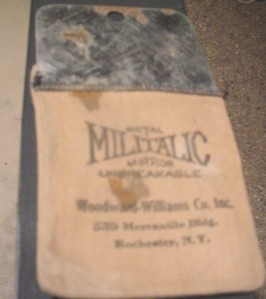Mirror Mirror in My Hand…
Did you ever think a mirror could save your life? Men who served in World War I and were in the trenches depended on the Militalic Mirror. The Militalic Mirror not only aided in trench warfare but also helped control to some extent disease.
Trench warfare was a hard life. At the start of World War I, the Germans made their trenches in high terrain which led to better living conditions and a better tactical advantage point. When the French and British armies dug their trenches they were forced to dig their trenches in lower terrain, which meant closer to sea level, horrible living conditions and less tactical advantage than the Germans possessed. When the Americans arrived to war and the trenches they found flooded trenches with rats cat sized, frogs, lice, insects and diseases because of the poor living conditions.
To help fight some diseases men would shave their heads and beards when they could. Lice would bury in the soldiers skin and cause the soldier to itch. To help prevent lice soldiers would shave their heads. The Militalic Mirror would come in use during the shaving, if water was available; sometimes shaving and washing were not an option for the men in the trenches. There is also debate over whether or not facial hair meant that the soldier’s gas mask was not sealed. If this was the case then shaving facial hair became of great importance as gas was a weapon used by the enemy.
Life in the trenches was hard by daylight, but night did not ease the hardships. The men would sleep in the trenches and on a cloudless night German planes would circle overhead waiting to drop bombs on the men in the trenches. If it wasn’t a bomb a well thrown grenade or sniper could reach the men in the trenches.
The land in between the armies’ trenches was known as “No Man’s Land” and was an area of mud and deep holes due to the artillery shells. When soldiers would charge an opposing trench they would call this going “Over the Top.” They would literally go over the top of their trench into “No Man’s Land” and be subjected to machine gun and artillery fire without cover. The Militalic Mirror was of use when wanting to go “Over the Top.” The Militalic Mirror could be used for looking over the top of a trench to see what was out beyond. It was also used a way of sending signals.
The Militalic Mirror was unbreakable and according to The Utica Observer of August 2, 1917, the metal Militalic Mirror was one of the necessities not given to the soldier in his equipment. Instead the mirror had to be purchased by the solider or given to him as a gift. It also stated that regulations demanded the soldier be clean shaven at all times. The Newspaper The Milbrook Mirror & Round Table ran an ad that asked civilians to send gifts of comfort to the boys fighting over seas during WWI. One of the items included Militalic Metal Mirror for 25¢ to 75¢ each that would include a cloth case and a mailing case.

MC635
Militalic Mirror used by Elmer Nelson between 1918-1919 during WWI
As you can see the Militalic Mirror had several purposes and was an item sent overseas to the soldiers. The Militalic Mirror we have in our collection was used by Elmer Nelson during World War I between 1918 and 1919. Nelson came from Cook Nebraska prior to World War I and settled a mile across the state line in Colorado, south of Kanorado. Eventually he and his family moved to into Kansas southwest of Kanorado. He and his wife had three sons and four daughters. His daughter Anna M. Monroe donated the mirror to us.
This mirror has a very rich background. It tells the story of a local soldier in the trenches and the hardships he faced there. We never know what an item may mean to someone but it is important to document the story of such items as this.
Does your family have a history of military service? Do you have objects around that were used by someone serving? Tell us your stories in the comments section below.
Look for more posts in this series about our wonderful collection of Sherman County history.